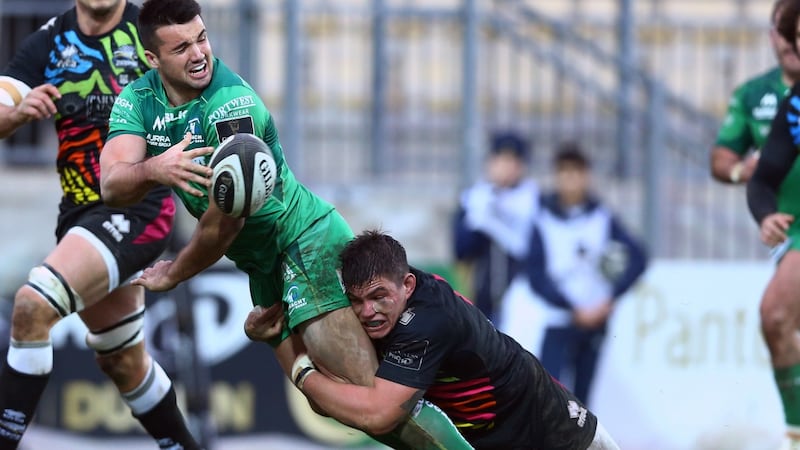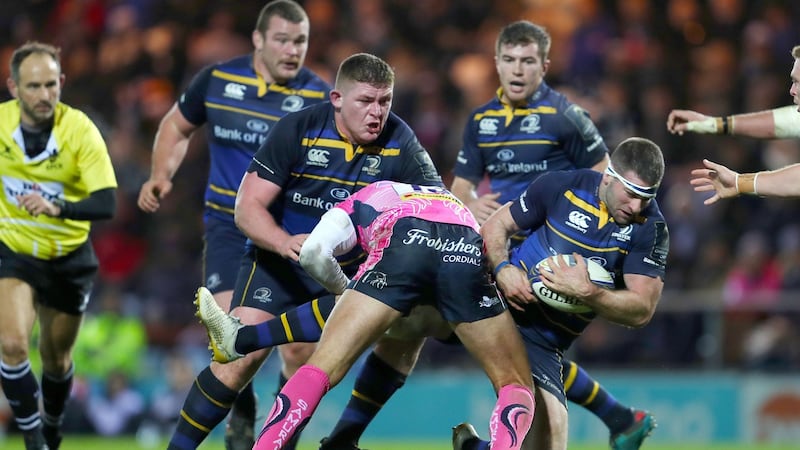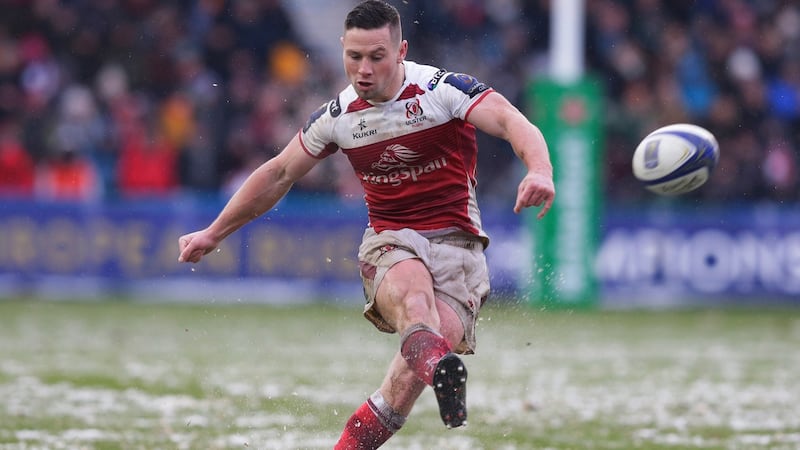When Leinster completed the sleeves-rolled-up win in Sandy Park last Sunday which reaffirmed their status as European Champions Cup contenders, 18 of their 23-man match-day squad were products of their provincial academy.
It was ever thus, but even so in this day and age of millionaire-owned and TV-financed clubs in England and France, it is a simply monumental achievement.
There is no other production line quite like it in the European game. Of their 45-man senior squad, 37 are home-grown products of their academy/pathway system, to which can now effectively be added Jordan Larmour, the brilliant 20-year-old who was making his ninth appearance of the season in Exeter and is the latest to be fast-tracked through the system.
Indeed, some pass through the academy system quicker than others who complete the three-year cycle, while another, Barry Daly, is a product of the club system and specifically UCD.
Nor does it stop there, for such is the conveyor belt of talent that it is spreading more than ever into the other provinces. Five of Munster's senior squad came through the Leinster set-up, with Andrew Conway and Ian Keatley full products of their academy.
Connacht has always been a home for those who missed the net or didn’t quite make the cut in Leinster, and there are currently 13 players in their squad who hail from Leinster or passed through their system.

This includes four players – Cian Kelleher, Gavin Thornbury, Tom Farrell and Steve Crosbie – who are graduates of Leinster's academy, as well as others who were in the Leinster sub-academy or underage teams. James Connolly, for example, was spotted playing for Newbridge by Nigel Carolan and brought into the Connacht academy.
This also illustrates how astute Connacht have been in identifying talent and in many instances bringing some of these players into their own academy or pathway.
What perhaps is even more eye-catching is how Leinster products are now also breaking into the Ulster set-up. As things stand, seven players on Ulster's roster hail from Leinster and given John Cooney has occasionally played at outhalf as well, with Marty Moore and Jordi Murphy to join, barring hooker Ulster could next season conceivably field a 1-10 of players who came through the Leinster system.
Leinster's production line is also an invaluable source of players for the Ireland Test squad, and last month they supplied 17 of the 36 players used in the Guinness Series despite Dan Leavy being ruled out through injury, and nor does that include Conway and Keatley.
Anywhere and everywhere
In football terms, Leinster are akin to Ajax in their 1980s pomp. Overseeing all this is the Leinster academy manager Peter Smyth, himself a product of the so-called Blackrock College 'Dream Team' which also featured Leo Cullen. He is quick to stress how much work goes into ensuring the success.
The academy and sub-academy are run by a staff of 13 full-time people, between coaches (Trevor Hogan, Leinster's provincial talent coach, Noel McNamara, Hugh Hogan and Simon Broughton), strength and conditioning, physios, nutrition and video analysts, based in both their UCD High Performance Centre and in Donnybrook.
“Then if you go down to the regions and other Leinster employees who are working with players, with CCOs and CROs, there could be anything between 50 and 100 people working on the ground doing various things, whether it be primary schools, national schools, clubs, regions. You can’t put a price on all the volunteers doing ‘minis’ and under-14s and Under-16s in clubs.” says Smyth.

"The Leinster academy is just a reflection of the province, and the work which goes on in the province. There are a lot of kids who come through the schools but you look at where Tadhg Furlong, Seán O'Brien and Adam Byrne are from, and then there are kids from St Michael's, Blackrock, Clongowes, Newbridge, St Andrews and so on, it is pretty democratised across the whole province, which is the big point. They're from anywhere and everywhere."
In the midst of these pivotal back-to-back games with the English champions, it seemed apt that the Leinster Schools Senior Cup draw was held last Monday night, with all its usual bells and whistles, at the Bank of Ireland branch in Grand Canal Square. In attendance were Stuart Lancaster, Leavy and Dave Kearney.
“There’s no doubt, the schools are the main source,” says Smyth. “If you look at those 37 players, and whether it’s an 80-20 or 70-30 split between schools and youths, it wouldn’t be 50-50, but there’d be a fair representation from each. When he first came in, Stuart couldn’t get over how many of the players knew each other from a young age, and they all came from roughly the same area.”
“Most of the guys who make it to the academy have probably known each other since they were 13, 14 or 15. They probably played against each other and/or with each other on representative teams. If you’re a good player in school or a club, the chances are you’re going to be in the senior team on a three-year cycle, so you’re going to mix with fellas two years ahead of you and two years behind you.”
Talent identification is a key component but, according to Smyth, “participation is the big thing because you’ve got to drive the numbers before talent identification starts. Participation is huge”.
Affiliated schools
To that end, with 78 clubs and 155 affiliated schools in the province, the playing base has never been broader in Leinster. Smyth cites the example of a school in Temple Carrig, a relatively new school just outside Greystones.
"Henry Hurley, an ex-Leinster player, is coaching down there. They have a team that is now very strong at under-15s, and that's a school that was only built about four or five years ago. There are a huge amount of other examples, like East Glendalough, that shows the game is growing in other schools outside the big schools."
Identifying talent starts from the 15/16 age group up until the Under-20s, at which there is a relative stop-off point, at which point Leinster also keep a keen eye on the club game.
The clubs very often introduce young players to the game at mini level, who then attend rugby-playing schools, as well as providing an alternative route to the top, or help to further develop academy players.
Furthermore, the traditional production line from the established rugby playing schools have latterly been supplemented, most notably by St Michael's, but also by schools such as St Andrew's, St Gerard's and Gonzaga.
Smyth attributes this to "the people who are there. Gonzaga have had Bobby Byrne and Declan Fassbender coaching there for a long, long time. It's due the influence of the main people in the school, through coaching, that the game thrives in those schools".
There are also late developers.
"Garry Ringrose is a classic example. Garry never played Leinster Schools or Leinster 19s, and he is where he is now. Garry came to prominence in his last year at Blackrock College. Take Barry Daly. Barry was the top try scorer in the AIL for UCD two years ago, when he was doing his accountancy exams.
“In a sport like rugby, where players mature at different rates, they’re all not going to come through a steady pathway from 15 or 16, all the way through to 20, and then become a pro. It just doesn’t happen like that.”
There are also more likely to be late developers in Leinster than anywhere else by dint of them simply having more players than any of the other provinces, perhaps the biggest advantage Leinster has over their provincial rivals.
“The reality is that the population is just bigger on the eastern seaboard than it is on the western seaboard,” Smyth concedes.
Monumental effort
As the number of Leinster players playing for the other provinces demonstrates, with the largest production line in the country, some are invariably either going to miss the net altogether or else move on. There is, perhaps, a danger that this could ultimately somewhat dilute the sense of identity and brotherhood which is such an integral part of each province but, as one of Leinster’s academy rivals stresses, it’s still preferable than bringing in overseas players and it also serves the Ireland squad.
Relatively few move abroad, although Leinster can also take pride in Ian Madigan at Bristol and Jerry Sexton, a former sub-academy lock who passed through Auch and Exeter, to also play in the Championship with Jersey Reds.
"Firstly, the players themselves have put in a monumental effort to get where they are as rugby players," says Smyth, "and for the coaches or others who had anything to do with, say, a Nick Timoney or a Jordi Murphy, isn't it great to say: 'We played a part in their journey.' Obviously when Leinster play Ulster, you're going to be up for Leinster, but you're also following all the guys that you know and you've come into contact with, and you're hoping that they do well. They're also Irish rugby teams. When Ulster are playing Harlequins, you want Ulster to do the business."
Last night, Smyth was in Donnybrook for the Leinster ‘A’ side’s rematch with Bristol, whom they beat 45-36 away last weekend in the British & Irish Cup. Coached by McNamara, 13 of last night’s 22-man squad are current members of the academy, while a further seven are academy graduates.

Leinster can have up to 22 players in their full academy, be it first, second or third year, and currently have 21. Ideally, they want to be producing six, seven or eight players at the end of each season.
“Players come through in waves and in cycles. It doesn’t balance up that you lose five players at the end of one season and you have five players ready to go.”
Another significant benefit of the system is that all 21 are in full-time third level education, so all of them are also currently sitting exams in college.
Student night
“It is true what they say, if you can achieve at a high level in one discipline, you can do it at a number of levels,” says Smyth. Between their rugby and studies, they’ve little time for anything else.
“They sacrifice a huge amount, such as living the normal life of a student or a 21- or 22-year-old. These guys aren’t going out for student night on Tuesday nights. They’re sacrificing a fair amount to be able to compete at an elite rugby level and also to be an academic achiever as well. Their time management is brilliant because it has to be.”
Beneath the academy, there are another 30 to 35 players in the sub-academy, who undergo strength and conditioning, skills coaching, physio and nutrition on one or two-year cycles, essentially giving them a taste of the life of a professional rugby player.
“The biggest challenge ahead is to ensure that you’re consistently producing professional players, and that those players are capable of winning titles for Leinster and Ireland. That is what Leinster is benchmarked on and what Ireland are benchmarked on. People want to see success, they want to see trophies, they want to see wins.
“So you’re constantly trying to make sure that players in the Leinster under-age system who we come in contact with one day will be in the Avivas or Twickenhams or Murrayfields or wherever it is, winning honours for Leinster and for Ireland, for many years to come.”
Keep on keeping on.
Leinster players who are in the other provinces
Munster
Andrew Conway – Blackrock College, Leinster academy.
Robin Copeland – Kilkenny College, Leinster sub-academy, Plymouth, Rotherham, Cardiff.
James Hart – Belvedere College, Clontarf, Grenoble.
Ian Keatley – Belvedere College, UCD, Leinster academy, Connacht.
Conor Oliver – St Mary's College, Leinster sub-academy, Blackrock.
Jack Power – Blackrock College, Leinster academy, Munster academy.
Connacht
Cian Kelleher – St Michael’s College, UCD, Leinster academy.
Gavin Thornbury – Blackrock College, Leinster academy.
Tom Farrell – Castleknock College, Leinster academy, London Irish, Bedford.
Eoghan Masterson – Portlaoise, Leinster under-age.
Matt Healy – Gonzaga, Leinster sub-academy, Lansdowne.
Niyi Adeolokun – De La Salle Churchtown, Leinster sub-academy, Trinity.
Peter Robb – Blackrock College, Leinster sub-academy, Old Belvedere.
Shane Delahunt – Kilkenny College, Leinster academy, Connacht academy.
Craig Ronaldson – Kilkenny College, Lansdowne.
Denis Buckley – Blackrock College.
Denis Coulsen – St Michael's College, Grenoble Academy.
James Connolly – Newbridge College, Connacht academy.
Steve Crosbie – St Gerard’s, Leinster academy.
Ulster
Eric O'Sullivan – Templeogue College, Trinity, Leinster sub-academy, Ulster academy.
Alan O'Connor – Skerries, UCD, Leinster sub-academy.
Jack Regan – Birr, Leinster sub-academy, Ulster academy.
Greg Jones – St Andrew's, UCD, Leinster sub-academy, Ulster academy.
Nick Timoney – Blackrock College, St Mary’s RFC, Leinster academy, Ulster academy.
Dave Shanahan – Belvedere College, Trinity, Leinster sub-academy, Ulster academy.
John Cooney – Gonzaga, UCD, Leinster academy, Connacht.
Next season
Marty Moore – Castleknock College, Lansdowne, Leinster academy, Leinster.
Jordi Murphy – Blackrock College, Leinster academy, Leinster.











